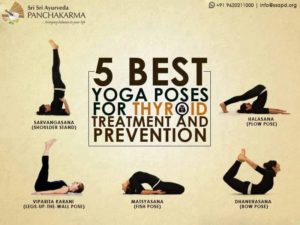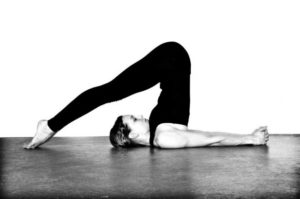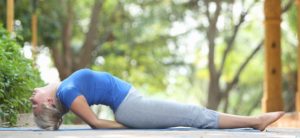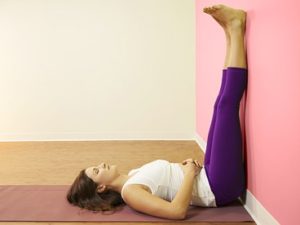Thyroid glands are known as the ‘orchestra instructors’ of our bodies. These glands control one of the most important functions of the body- Metabolism, or, how the body cells utilize energy from our food sources. Thyroid glands secrete hormones called Thyroxin that regulate metabolism. Any imbalance in the amount of hormone secreted could cause either Hyperthyroidism or Hypothyroidism. Both these conditions affect body weight, sleep cycle, digestion and other crucial bodily functions.
What is Hyperthyroid and Hypothyroid?
Excess of hormone secretion from enlarged thyroid glands causes Hyperthyroidism. Some of its symptoms are unexplained weight loss, physical weakness, insomnia, and irregularity in the heart beat. Hypothyroid, on the other hand, is an underactive thyroid gland. Under this condition, the gland produces insufficient amounts of thyroxin.

Here we discuss some Yoga poses that improve metabolism and keep your thyroid glands healthy and happy.
1) Bow Pose (Dhanurasana)
- Lie down on your stomach. Let there be a slight gap between your feet.
- Place your arms by the sides of your body.
- Taking your hands backwards, folding up your knees, try and hold your ankles in the shape of a bow.
- As you breathe in, try to lift your chest off the floor.
- Try pulling your ankles towards you for a better grip.
- Let your face be straight and chin up.
- Stay in the pose for a few deep breaths and observe your breath. Make sure you are comfortable in this pose and do not overdo the stretch.
- As you breathe out, slowly release the hold and relax.
Benefits of Bow Pose
- Good for strengthening the back and abdominal muscles
- Loosens up the chest, shoulders and the neck.
- Good for thyroids
- Stress Buster
- Good for relieving menstrual pain.
- Good for renal disorders
When should you not do it?
-blood pressure, Hernia, injured neck, hurt lower back or post-abdominal surgery
2. Plow Pose (Halasana)
- For this, flip over to lie on your back with the arms on the sides, facing the floor and legs straight on the floor.
- As you breathe in, with the help of your abdominal muscles, lift your legs off the floor, bringing them perpendicular to the floor.
- As you breathe out, bring your legs full circle all the way behind your head. As you do this, make sure you do this very gently and only as much as your body permits.
- try to make your back perpendicular to the floor as you hold the asana.
- Steady your breath in the pose.
- After a few breaths, release the posture very slowly, as slowly as possible and return to the corpse pose.
Benefits of the Halasana (Plow Pose)
- Good for loosening and strengthen the neck, shoulders, and back muscles.
- Calming on the nervous system
- Stimulates thyroid glands
- Improves immunity
- Calms the nervous system, reduces stress and fatigue.
- Helps women through menopause.
When should you avoid practicing Halasana
If you have neck injury, pregnancy, first two days of menstrual cycle, spinal disorder, weak stomach or high blood pressure.
3. Fish Pose (Matsyasana)
- Lie on your back with feet together and hands relaxed by the sides.
- Bring your hands with palms facing the floor, under your hips. The effort should be to bring the elbows towards each other.
- As you breathe in, lift your head up, chest up and slowly let the head drop so that the top of your head is touching the floor.
- Place the weight on your elbows. Let the lifting happen from the region between the shoulder blades.
- Press the thighs and legs into the floor
- Stay there for a few breaths. As you breathe out, release the pose slowly, lifting up the heads first, lowering the chest and then the head.
Benefits of Fish Pose
- Relieves the tension and stiffness in the neck and shoulder region
- Good for toning the pituitary and thyroid glands
Do not do it if you have
-Blood pressure, migraine or insomnia, lower back and neck injuries.
4) Legs-up-the-wall Pose ( Viparita Karani)
 Sit sideways on the rolled blanket or a rolled yoga mat.
Sit sideways on the rolled blanket or a rolled yoga mat.- The right side of your body should be against the wall.
- As you breathe out, turn to the right, lower your shoulders to the floor and puts your legs up against the wall.
- Let your arms support the opening of the front of your chest.
- Stay here in this pose for a few deep breaths.
- To release the posture, slide off the support slowly and keep lying down for a few breaths before gradually sitting up.
5. Shoulder Stand (Sarvangasana)
- Lie on the back with hands by the side.
- At one go, slowly lift your legs up, then the buttocks and then the back such that only your head, neck and shoulders are on the ground.
- Try and bring the elbows closer to each other and your hands can be supporting the hips and back region.
- Make sure, the weight of your body is held by the shoulders and not by the head and neck.
- Try to straighten up the leg. Do only as much as your body permits. If your body quivers, then stop right there.
- Push the toes higher into the sky.
- Try to bring the sternum closer to the chest in this posture.
- Make sure, your neck is not digging into the floor. Keep it tight.
- If you feel the slightest neck strain, come out of the posture slowly.
- As you breathe out, lower your knees first bringing them down to the forehead. Bring down your hands to their original position. Keeping your head in its place, lower the spine slowly to the floor as one by one each vertebra coming down.
- Keep lying on the floor for a few deep breaths. Observe the sensations in the body.
Benefits of Shoulder Stand
- Works to stimulate the thyroid and parathyroid glands and improves metabolism
- Good for stronger arms, shoulder, and spine
- Circulation of blood improves.
- Good for the heart
- Good for those suffering from constipation or indigestion
Do NOT do this asana if you have
- Menstrual cycle, pregnancy, heart problems, blood pressure, glaucoma, neck, back or acute thyroid issues.
6. Yoga Nidra
After the poses and stretches, lie down and relax with Yoga Nidra or Yogic sleep. The Yoga Nidra is known to give deep rest equivalent to four hours of sleep. Though we do not suggest, you skip your beauty sleep. Yoga Nidra can give you rest equal to a couple of hours of sleep. Listen to this soothing guided Yoga Nidra and catch up on some good quality rest.
Image Credits
Image with all asanas- Sri Sri Ayurveda Panchakarma Center Bengaluru
Bow pose- www.artofliving.org
Plow pose- www.yoganonymous.com
fish pose- www.artofliving.org
legs up the wall pose- otlfitness.com










